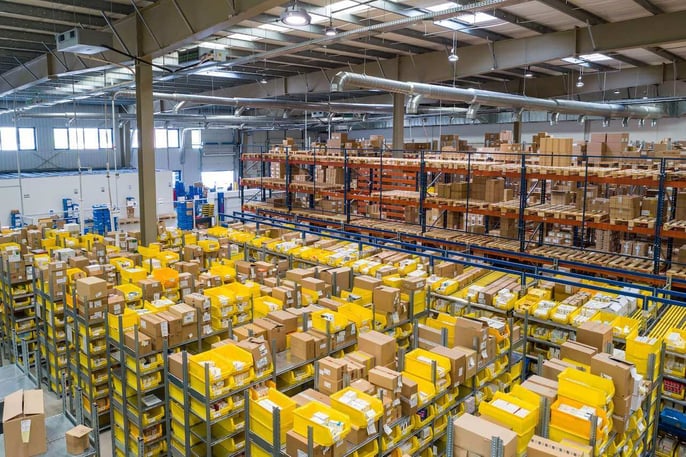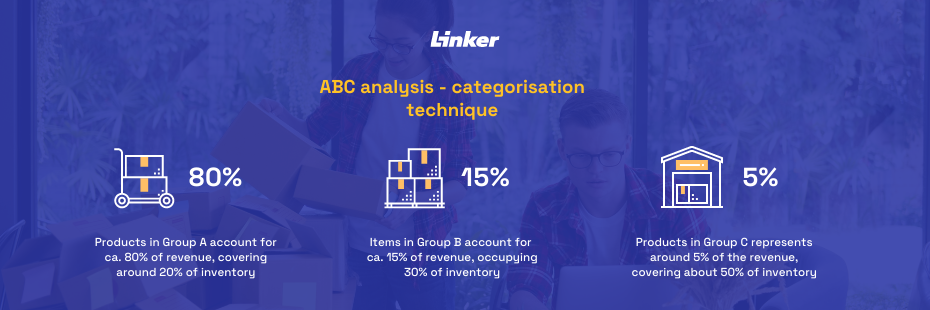In order to answer your request, we are obligated to process the data given above. Sometimes, however, we would like to use them for slightly different purposes, such as statistical data or informing you about our new products and services.We promise that we will use the given information for communication purposes only. We also remind you that you can unsubscribe from our mailing at any time (see Privacy Policy).
Inventory management is a crucial part of business, which involves controlling the quantity and type of products stock, analysing sales trends, or reviewing purchases. The better and more effectively this area of activity is carried out, the lower the costs and potential losses. This applies to the entire group of companies operating in the retail industry, based on a business to business (B2B), business to customer (B2C), or direct to consumer (D2C) model.
And you? Are you managing your stock properly?
What inventory management means?
Simplifying, we can say that it is a system that organises the stocks of your online business through the supply chain. Depending on the type of business model, whether it's just retail or also manufacturing, inventory management allows you to monitor sourcing at every stage - from raw materials and semi-finished products to the final goods.
Besides, it's providing information on how they are stored - where they are located, what their size and weight are. Finally, well-designed inventory management also shows how sales relate to inventory, what is overstocked and what is supposed to be out of stock, and when to replenish the warehouse.
Admit that it is difficult to imagine an eCommerce business that would function well without all this information, isn't it?
How does inventory management boost results in the online store?
Despite the size of the company, well-placed inventory management processes allow on the one hand to reduce costs and on the other to increase revenues. Why? Because properly organised inventory management enables to save on storage costs and earn on the ability to highly satisfy customer needs.
The benefits of good management are:
Less out-of-date products
Of course, in this case, a lot depends on what goods you sell. If these are for example foodstuffs with an expiry date, it's worth keeping an eye on how long they can be sold. Otherwise, products held beyond their best-before dates will generate losses.
Reduced deadstock
This term describes all those products which, for whatever reason, can no longer be sold. These are often seasonal products, launched on holidays such as Christmas or celebrations like St. Valentine's Day. They are also goods which have gone out of style. No matter why storing such products generates considerable costs
Storage savings
Storage costs increase with the number of goods kept in a warehouse. Online retailers often use external facilities and pay for a certain amount of space. Thanks to the optimisation of inventory management processes there will be a rotation of products, you gain a possibility to limit the warehouse overload and be able to make savings.

Improved financial management
If you are wondering how well-managed inventory may improve cash flow in online business, we are about to explain.
In most cases, what is in stock has already been paid for. One of the factors contributing to a stable flow of money is the regular eCommerce transactions of accumulated goods. If for any reason this cycle of buy and sell is interrupted, for example, because some products are simply not selling, then financial stability is disrupted.
So, the conclusion is simple: if your inventory management system is right, you have real-time control of your stock, you know what is selling and what you need to buy soon. The balance of income and expenses is the basis of proper financial management.
Better fulfillment
Inventory management also improves the quality of order fulfillment in the online store. Mainly because it minimises the risk of error and allows you to plan warehouse locations, spreading your supplies across different parts of the country (or the world), making online shopping easier.
Inventory management in electronic commerce: getting started
Now that we have provided some basic information on inventory management, it would be useful to outline how to prepare for setting up this process in business.
Small businesses, whether we are talking about traditional retailers or online services (mobile commerce, online retailers), very often rely on manual inventory management systems. The truth is that up to a certain point it can be a good solution. However, there will come a time when it consumes increasingly more time and attention, and the greater the human dependence on these activities, the higher the chance of a mistake. You don't have to be one of the large corporations with many sales channels to benefit from a more complex system.
All things are in their time, so let us start from the beginning.
Analyse the categories of sell products
It is worth doing this analysis regularly to understand how customer demand relates to the category of products you sell. By considering the interest of buyers in the previous year, or in the last few years, you can see when a sales peak occurs and how long it lasts.
If you already have an online shop, Google Analytics is a useful tool that can show you which products attract customers when they visit your shop and what can influence their decision-making. So replenishment of the warehouse becomes more predictable.
Set a minimum stock for each product
Whether your online store is already up and running or you're planning one, it's worth considering setting a minimum stock level for each product in your inventory coordination. The goal is to find the lowest possible storage level to meet customer demand and avoid delays in order fulfillment. This number can of course change over time, so do not be afraid to verify the first assumptions.
Pssst...
(If you're curious about how Linker Cloud manages stocks, be sure to read our Tech Overview series).
.png?width=1170&name=MicrosoftTeams-image%20(7).png)
Prioritisation using the ABC method
It is a very simple method of categorising products, from lowest to highest value and is based on Pareto principle. When reviewing an inventory, you can assign items to groups A, B, or C.
- In category A we place the products with the highest value and the lowest quantity.
- In category B we can assign products of moderate value and average quantity.
- Category C contains the products with the lowest value and the highest quantity.
To put it another way: the products in Group A account for ca. 80% of revenue, covering about 20% of inventory. Group B items account for ca. 15% of revenue, occupying around 30% of inventory. Group C represents about 5% of the revenue, occupying around 50% of the warehouse capacity.
By starting to work with this method you can find out which products and online purchases are the most beneficial to conduct business better.

Time for an inventory management system
It is hard to imagine eCommerce sites or traditional retailers not needing an inventory management system over time. Whether you sell goods and services through traditional channels (for example health services) or deal in digital products (like e-learning) that are primarily consumed by internet users, when you decide to grow and scale your business, investing in software is simply essential.
Thanks to this system, you will be able to know the level of stocks of individual products, what is happening with them in real-time (whether they have been sold, returned, or exchanged), make a summary of the entire year, or plan the automation of purchase orders.
Inventory management software is one of those elements that is quite easy to adapt to customer requirements. Therefore, finding the right system should not be too difficult, even if your needs are slightly different from the standard. The market is already able to offer solutions that earn high marks in the eCommerce industry.
High awareness of what is happening at the resource level in your business will also enable you to reach your target audience more effectively, depending on whether they are using mobile devices or desktop equipment and what products and services they are looking for. Using software makes many aspects of running a business online much simpler.
Summary
We believe that the material prepared leaves no doubt as to the importance of proper inventory management for eCommerce websites running retail sales and other companies in general.
High sales results depend on the behaviour of consumers, reasons why people shop, and what they're looking for. The whole process is mutual learning between buyers and sellers, marketing and analysis of e-commerce transactions.
Continuous development in inventory management is one of the indicators of success for an eCommerce site.






